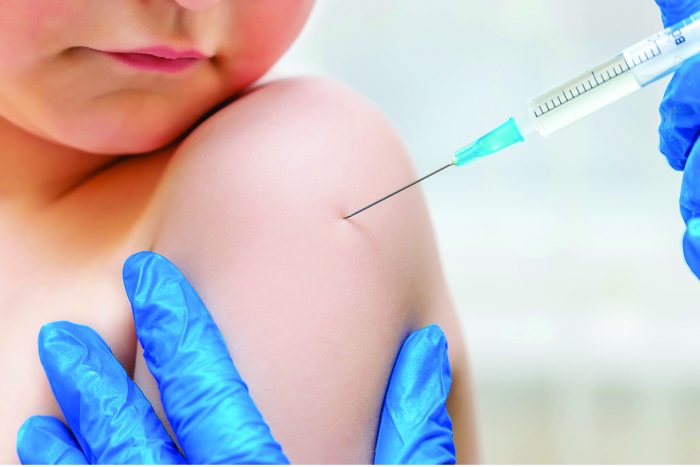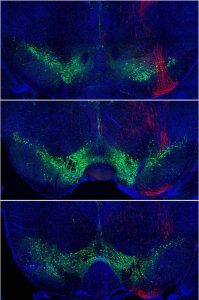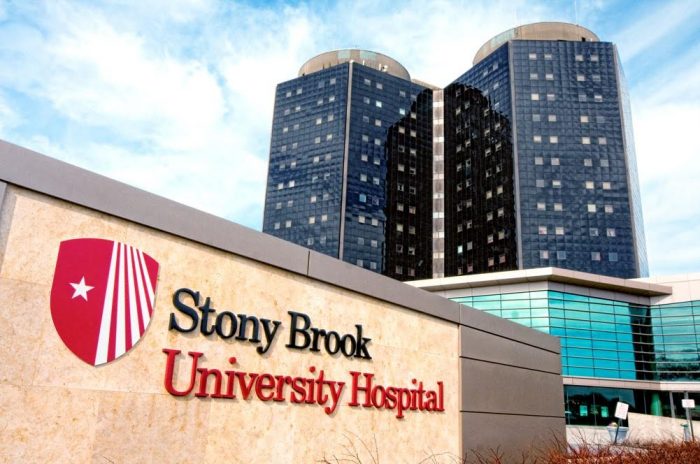This article was updated on Nov. 10.
A total of 107 Stony Brook Medicine physicians have been named “Top Doctors” on New York Magazine’s 2021 list. The list includes doctors from Stony Brook University Hospital, Stony Brook Southampton Hospital, and Stony Brook Eastern Long Island Hospital, across more than 45 different specialties. The “Top Doctors” list represents the top 10% of New York area physicians.
“The Stony Brook Medicine healthcare system is distinguished not only by the number of physicians named as top doctors, but also by the range of 45 specialties represented,” said Carol A. Gomes, MS, FACHE, CPHQ, Chief Executive Officer for Stony Brook University Hospital. “Every day, our physicians deliver high-quality care to patients, making a significant difference in their lives.”
New York Magazine generates its annual “Top Doctors” list for the New York metro area based on peer-reviewed surveys from Castle Connolly Medical Ltd., a New York-based research and information company. Each year, Castle Connolly surveys tens of thousands of practicing physicians across the US to ensure its list reflects the latest in quality care on both the national and regional levels. The company evaluates several criteria when selecting Top Doctors, including professional qualifications, education, hospital and faculty appointments, research leadership, professional reputation and disciplinary history. Through Castle Connolly’s research process, only 60,000 board-certified physicians out of 850,000 practicing doctors in the United States have been awarded Top Doctor status.
The Stony Brook Medicine “Top Doctors” featured in New York Magazine’s 2021 list by specialty are:
Adolescent Medicine
- Allison H. Eliscu, MD, Stony Brook University Hospital Attending Physician
Allergy & Immunology
- Daniel L. Mayer, MD, Community Physician
- Erin E. McGintee, MD, Community Physician
- Michael Steven Richheimer, MD, Community Physician
- Susan Schuval, MD, Stony Brook University Hospital Attending Physician
Cardiac Electrophysiology
- Eric J. Rashba, MD, Stony Brook University Hospital Attending Physician
- Roger Fan, MD, Stony Brook University Hospital Attending Physician
Cardiovascular Disease
- Emanuel D. Chryssos, MD, RPVI, Stony Brook Medicine Community Medical Group Physician
- Hal A. Skopicki, MD/PhD, Stony Brook University Hospital Attending Physician
- Lev Lubarsky, DO, FACC, FASE, FSCCT, Stony Brook Medicine Community Medical Group Physician
- Mark G. Borek, MD, Community Physician
- Michelle Weisfelner Bloom, MD, Stony Brook University Hospital Attending Physician
- Thomas A. Falco, MD, Community Physician
Child & Adolescent Psychiatry
- Gabrielle A. Carlson, MD, Stony Brook University Hospital Attending Physician
Colon & Rectal Surgery
- Arnold R. Leiboff, MD, Community Physician
- Paula Irina Denoya, MD, Stony Brook University Hospital Attending Physician
- William B. Smithy, MD, Stony Brook University Hospital Attending Physician
Dermatology
- Leonard Kristal, MD, Stony Brook University Hospital Attending Physician
Diagnostic Radiology
- Elaine S. Gould, MD, Stony Brook University Hospital Attending Physician
- Kathleen C. Finzel, MD, Stony Brook University Hospital Attending Physician
- Pablo R. Ros, MD, Stony Brook University Hospital Attending Physician
- Seth O. Mankes, MD, Stony Brook University Hospital Attending Physician
Endocrinology, Diabetes & Metabolism
- Alan Goldenberg, MD, Community Physician
- Marie Gelato, MD/PhD, Stony Brook University Hospital Attending Physician
Family Medicine
- Alex M. Aponte, MD, Westhampton Primary Care Ctr Community Physician
- James E. Giugliano, DO, Community Physician
- Joseph White, MD, Community Physician
Gastroenterology
- Jonathan M. Buscaglia, MD, Stony Brook University Hospital Attending Physician
- Joseph Duva, MD, Community Physician
- Juan Carlos Bucobo, MD, FASGE, Stony Brook University Hospital Attending Physician
Gynecologic Oncology
- Michael L. Pearl, MD, Stony Brook University Hospital Attending Physician
- William M. Burke, MD, Stony Brook University Hospital Attending Physician
Hematology
- Michael W. Schuster, MD, Stony Brook University Hospital Attending Physician
Internal Medicine
- John Oppenheimer, MD, Community Physician
- Lloyd D. Simon, MD, Stony Brook Medicine Community Medical Group Physician
- William A. Wertheim, MD, Stony Brook University Hospital Attending Physician
- Xiaolei Zhu, MD, Stony Brook University Hospital Attending Physician
Interventional Cardiology
- William E. Lawson, MD, Stony Brook University Hospital Attending Physician
Maternal & Fetal Medicine
- James Bernasko, MD, Stony Brook University Hospital Attending Physician
Medical Oncology
- Noshir Anthony DaCosta, MD, Community Physician
Neonatal-Perinatal Medicine
- Aruna J. Parekh, MD, Stony Brook University Hospital Attending Physician
Nephrology
- Mark David Solomon, MD, Community Physician
Neurology
- Patricia K. Coyle, MD, Stony Brook University Hospital Attending Physician
Neuroradiology
- David J. Fiorella, MD, Stony Brook University Hospital Attending Physician
- Robert Peyster, MD, Stony Brook University Hospital Attending Physician
Obstetrics & Gynecology
- Constantine Bakas, DO, FACOG, Stony Brook Medicine Community Medical Group Physician
- David A. Baker, MD, Stony Brook University Hospital Attending Physician
- Deborah Morgan Davenport, MD, Community Physician
- Pedro R. Segarra, MD, FACOG, Stony Brook Medicine Community Medical Group Physician
- Todd R. Griffin, MD, Stony Brook University Hospital Attending Physician
Ophthalmology
- Gideon L. Schneck, MD, Voluntary, SB Clinical Practice Management Plan, Inc. (CPMP) Physician
- Lawrence M. Buono, MD, Community Physician
- Pamela A. Weber, MD, Community Physician
- Patrick A. Sibony, MD, Stony Brook University Hospital Attending Physician
- Paul A. Choinski, MD, Community Physician
- John F. Romanelli, MD, Community Physician
- John R. Wittpenn, MD, Community Physician
Otolaryngology
- Craig M. Litman, MD, Community Physician
- Eric Thomas Scarbrough, MD, Community Physician
- James C. Marotta, MD, Community Physician
- Paul J. Davey, MD, Community Physician
- Paul Kelly, MD, Community Physician
Orthopaedic Surgery
- Edward D. Wang, MD, Stony Brook University Hospital Attending Physician
- Fazel Khan, MD, Stony Brook University Hospital Attending Physician
- Nicholas Divaris, MD, Stony Brook University Hospital Attending Physician
- Stephen A. Kottmeier, MD, Stony Brook University Hospital Attending Physician
- Steven P. Sampson, MD, Stony Brook University Hospital Attending Physician
Pathology
- Carmen Tornos, MD, Stony Brook University Hospital Attending Physician
Pediatrics
- Barbara J. Cusumano, MD, FAAP, Stony Brook Medicine Community Medical Group Physician
- Joseph B. Quinn, MD, FAAP, Stony Brook Medicine Community Medical Group Physician
- Lev Chernobilsky, MD, Community Physician
- Michael P. Nussbaum, MD, Community Physician
- Richard Sosulski, MD, Community Physician
Pediatric Cardiology
- Peter Morelli, MD, Stony Brook University Hospital Attending Physician
Pediatric Gastroenterology
- Anupama Chawla, MD, Stony Brook University Hospital Attending Physician
- Keith John Breglio, MD, Stony Brook University Hospital Attending Physician
Pediatric Infectious Disease
- Christy Beneri, DO, Stony Brook University Hospital Attending Physician
- Sharon A. Nachman, MD, Stony Brook University Hospital Attending Physician
Pediatric Pulmonology
- Catherine E. Kier, MD, Stony Brook University Hospital Attending Physician
Pediatric Rheumatology
- Julie Cherian, MD, Stony Brook University Hospital Attending Physician
Pediatric Surgery
- Christopher S. Muratore, MD, Stony Brook University Hospital Attending Physician
- Richard J. Scriven, MD, Stony Brook University Hospital Attending Physician
Pediatric Urology
- Robert Wasnick, MD, Stony Brook University Hospital Attending Physician
Physical Medicine & Rehabilitation
- Timur Yasin, MD, Stony Brook Medicine Community Medical Group Physician
Plastic Surgery
- Alexander B. Dagum, MD, Stony Brook University Hospital Attending Physician
- Elliot B. Duboys, MD, Community Physician
- John R. Anton, MD, Community Physician
- Mark D. Epstein, MD, Community Physician
Psychiatry
- Richard N. Rosenthal, MD, Stony Brook University Hospital Attending Physician
Pulmonary Disease
- Keith Harris, DO, Stony Brook Medicine Community Medical Group Physician
- Howard M. Sklarek, MD, Community Physician
Radiation Oncology
- Samuel Ryu, MD, Stony Brook University Hospital Attending Physician
Rheumatology
- Howard B. Blumstein, MD, Community Physician
- Luiziana Manuela Marinescu, MD, Community Physician
- Paul E. Schulman, MD, Community Physician
Surgery
- Aaron R. Sasson, MD, Stony Brook University Hospital Attending Physician
- Aurora D. Pryor, MD, Stony Brook University Hospital Attending Physician
- Brian J. O’Hea, MD, Stony Brook University Hospital Attending Physician
- Daniel Rutigliano, DO, Stony Brook University Hospital Attending Physician
- Marc J. Shapiro, MD, Stony Brook University Hospital Attending Physician
- Sherif R. Abdel-Misih, MD, Stony Brook University Hospital Attending Physician
Thoracic & Cardiac Surgery
- Allison J. McLarty, MD, Stony Brook University Hospital Attending Physician
Urogynecology/Female Pelvic Medicine & Reconstructive Surgery
- Lauri Budnick, MD, Stony Brook University Hospital Attending Physician
Urology
- Daniel Han, MD, Community Physician
- Frank Darras, MD, Stony Brook University Hospital Attending Physician
- Howard L. Adler, MD, Stony Brook University Hospital Attending Physician
Vascular Surgery
- Apostolos K. Tassiopoulos, MD, Stony Brook University Hospital Attending Physician
About Stony Brook Medicine:
Stony Brook Medicine integrates and elevates all of Stony Brook University’s health-related initiatives: education, research and patient care. It includes five Health Sciences schools — Renaissance School of Medicine, Dental Medicine, Health Technology and Management, School of Nursing and School of Social Welfare — as well as Stony Brook University Hospital, Stony Brook Southampton Hospital, Stony Brook Eastern Long Island Hospital, Stony Brook Children’s Hospital and more than 200 community-based healthcare settings throughout Suffolk County. To learn more, visit www.stonybrookmedicine.edu.
About Stony Brook University Hospital:
Stony Brook University Hospital (SBUH) is Long Island’s premier academic medical center. With 624 beds, SBUH serves as the region’s only tertiary care center and Regional Trauma Center, and is home to the Stony Brook University Heart Institute, Stony Brook University Cancer Center, Stony Brook Children’s Hospital and Stony Brook University Neurosciences Institute. SBUH also encompasses Suffolk County’s only Level 4 Regional Perinatal Center, state-designated AIDS Center, state-designated Comprehensive Psychiatric Emergency Program, state-designated Burn Center, the Christopher Pendergast ALS Center of Excellence, and Kidney Transplant Center. It is home of the nation’s first Pediatric Multiple Sclerosis Center. To learn more, visit www.stonybrookmedicine.edu/sbuh.
About Stony Brook Southampton Hospital:
With 124 beds, Stony Brook Southampton Hospital (SBSH) is staffed by more than 280 physicians, dentists, and allied health professionals representing 48 medical specialties. A campus of Stony Brook University Hospital, SBSH offers a diverse array of clinical services, ranging from primary medical care to specialized surgical procedures, including cardiac catheterization, orthopedics and bariatrics. The sole provider of emergency care on Long Island’s South Fork, Stony Brook Southampton Hospital is a provisional Level III adult Trauma Center. The hospital includes The Phillips Family Cancer Center, a Heart and Stroke Center, Breast Health Center, The Center for Advanced Wound Healing, Wellness Institute, and 32 satellite care centers throughout the South Fork of Long Island. The hospital is the largest employer on the South Fork with more than 1,200 employees. To learn more, visit www.southampton.stonybrookmedicine.edu.
About Stony Brook Eastern Long Island Hospital:
With 70 beds, Stony Brook Eastern Long Island Hospital (SBELIH) is a full-service, community hospital committed to delivering excellence in patient care and meeting all the health needs of the North Fork and Shelter Island. A campus of Stony Brook University Hospital, SBELIH provides regional behavioral health programs serving the greater Suffolk County area. Centers of excellence include Medical-Surgical, Advanced Ambulatory Care, Behavioral Health, Emergency, Geriatric, Diagnostic Services, Physical Therapy and Gastrointestinal Services. To learn more, visit www.elih.stonybrookmedicine.edu.
Credit: Stony Brook Medicine



















